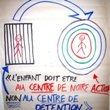
DIVERSION AND ALTERNATIVES
TOOLKIT
| |
| Home |
| Introduction |
| What are diversion & alternatives? |
| Why are they important? |
| How do we do them? |
| Resources |
| FAQs |
| Key reference documents |
UNICEF toolkit on diversion & alternatives to detention |
Diversion and alternatives are therefore often prioritised in UNICEF's work. This toolkit provides clear, user-friendly guidance and practical tools for UNICEF Child Protection Specialists and others working in this important field.
Using this toolkit will enable readers to gain a better understanding of diversion and alternatives to detention and to access a range of resources to assist with practical implementation.
Quick definitions: Diversion - means the conditional channelling of children in conflict with the law away from judicial proceedings towards a different way of resolving the issue that enables many - possibly most - to be dealt with by non-judicial bodies, thereby avoiding the negative effects of formal judicial proceedings and a criminal record. Alternatives to detention - refers to measures that may be imposed on children who are being formally processed though the criminal justice system, at both pre-trial and sentencing stages, that do not involve deprivation of liberty.
|
| Quick links | ||
|
||

